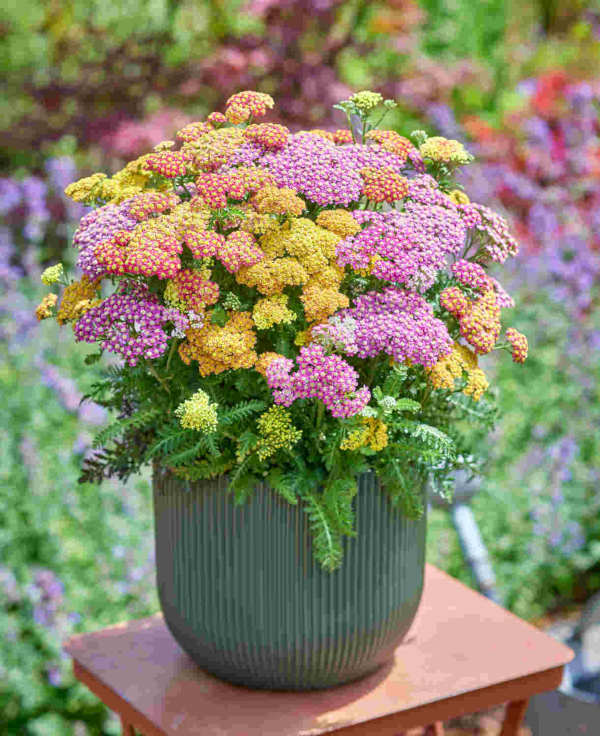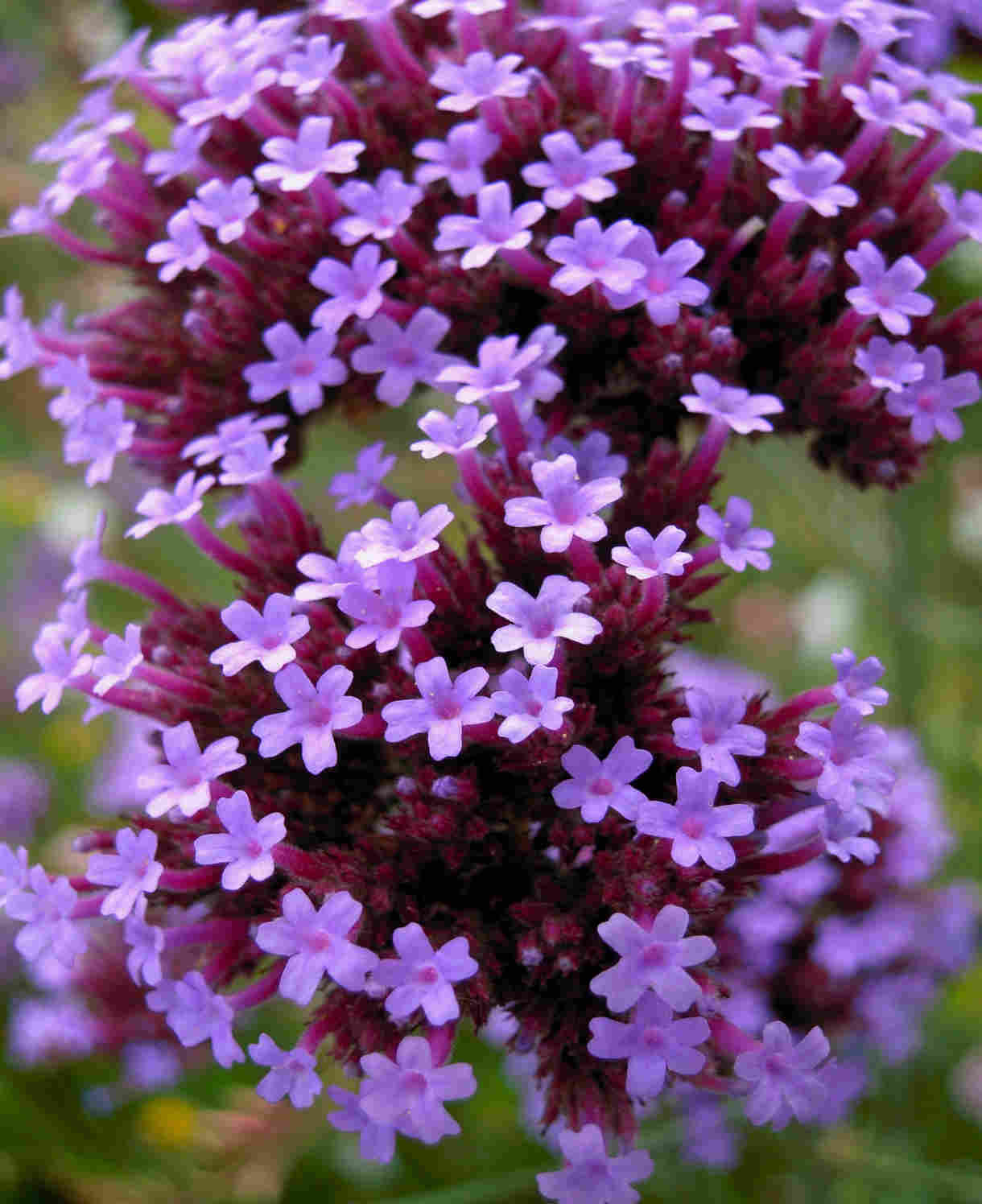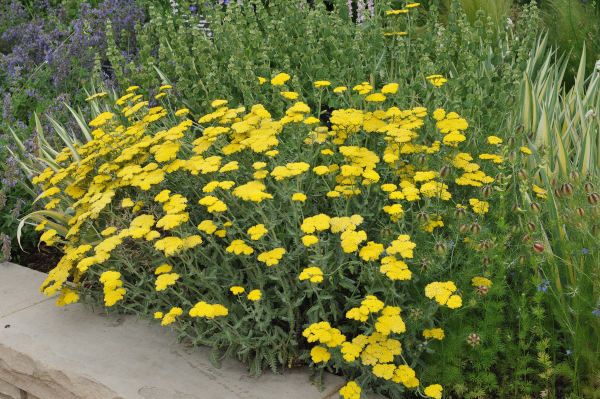How to grow Achillea
Achillea are either upright or mat-forming perennials – this makes it important for you to check your chosen variety’s height and spread prior to planting. Uprights grow to approximately 1.2m tall with a spread of 40-50cm. Mat-forming types are around 50cm tall with a spread of 30-40cm. All are semi-evergreen and fully hardy to -15°c. Achillea like a spot in moist, well-drained soil where they will flower for weeks at a time from early summer to early autumn. Achillea is an ideal plant for naturalising and cutting and is great for wildlife too. It enjoys a sunny site at the front or middle of the border (depending on variety) as well as being suitable for containers. Available in a rainbow of colours, Achillea will grow in exposed as well as sheltered sites and many hold the RHS Award of Garden Merit.

Key Information
Soil pH
Position
Hardiness


Where & when to plant Achillea
Position - Full sun to partial shade
Soil - Well-drained
Flowering Period - June-October
Hardiness - Hardy perennial
Young Achillea plants should be planted straight into the ground in spring and will flower from June well into autumn during their first year.
You can also plant Achilleas out in autumn whilst the soil is still slightly warm, and they will put roots down before the winter cold – making them ready to flower from early summer the following year.
Achilleas thrive in full sunshine, so choose a spot which is ideally south-facing and receives a generous amount of sunlight per day if a profusion of blooms is essential. They will tolerate partial shade but may not flower quite so much as a consequence.
The flat-topped blooms look great when planted en masse as they form a visual platform of colour in the border; plant several together for the best impact.
Space your plants at least 30cm apart (and further apart for larger varieties such as Summer Gold) as Achillea can be susceptible to mildew without adequate airflow between plants. Some varieties can grow to over 1m tall so be mindful of the varieties you are growing when choosing a planting site – taller plants are best placed towards the middle or back of the border.
Once you have chosen a suitable spot, dig a hole a little deeper and wider than your potted plant. If you grow on clay soil or ground which is prone to waterlogging, add a trowel-full of grit to the bottom of the planting hole as Achillea plants require good drainage.
Tease your Achillea plant out from its pot and loosen the roots a little before placing in the hole, with the top of the root-ball level with the surface of your soil. Fill in around the edges of the plant with soil and firm around the base of the plant before watering in well.
Keep young plants well-watered until they have established themselves.
How to care for Achillea
Achilleas are easy-to-grow, drought tolerant plants which do not usually require watering once established. In addition, they do not need regular feeding and will even thrive in poor soil conditions.
In order to prolong flowering, and promote a possible second flush of blooms, spent flowerheads should be cut back in mid to late summer. Achillea stems make excellent cut flowers, lasting a week or longer in the vase. They also make a great filler flower next to other summer annuals and roses in the garden. The scent of Achillea is not particularly ‘floral’ so be sure to add some fragranced flowers to your arrangement for perfume.
Achillea are hardy herbaceous perennials which die back to ground level for winter. You can leave the spent foliage on the plants over winter then remove and compost it in spring – just as the green growth emerges.
Young Achillea flowerheads and buds can be prone to aphid attacks although this is often taken care of by ladybirds who will enjoy feasting on the bugs. Allow nature to take its course if you can and the balance should be restored by the time the blooms are fully out. If the infestation is particularly bad, avoid using chemicals on your plants and spray them with a weak solution of eco-friendly washing up liquid mixed with water every few days, until the aphids have gone.

What to plant with Achillea
Achillea pair well with so many other plants in the garden and look fantastic in a traditional mixed border, or cottage garden, where they will bring texture as well as vibrant or subtle colour. They also work well in gravel or prairie gardens dure to their tolerance of dry and poor soils.
We think that Achillea looks great with Verbena bonariensis, Ornamental grasses, Scabiosa, Phlomis, Roses, Phlox, Allium sphaerocephalon, Rudbeckia, Hardy geraniums, Echinacea, Salvias, Penstemon, Monarda, Veronica, Chocolate cosmos, Echinops, and Gaura.
Please contact our wonderful Customer Care Team at Hayloft if you need any further guidance or planting suggestions for your Achillea plants.



How to care for Achillea
Achilleas are easy-to-grow, drought tolerant plants which do not usually require watering once established. In addition, they do not need regular feeding and will even thrive in poor soil conditions.
In order to prolong flowering, and promote a possible second flush of blooms, spent flowerheads should be cut back in mid to late summer. Achillea stems make excellent cut flowers, lasting a week or longer in the vase. They also make a great filler flower next to other summer annuals and roses in the garden. The scent of Achillea is not particularly ‘floral’ so be sure to add some fragranced flowers to your arrangement for perfume.
Achillea are hardy herbaceous perennials which die back to ground level for winter. You can leave the spent foliage on the plants over winter then remove and compost it in spring – just as the green growth emerges.
Young Achillea flowerheads and buds can be prone to aphid attacks although this is often taken care of by ladybirds who will enjoy feasting on the bugs. Allow nature to take its course if you can and the balance should be restored by the time the blooms are fully out. If the infestation is particularly bad, avoid using chemicals on your plants and spray them with a weak solution of eco-friendly washing up liquid mixed with water every few days, until the aphids have gone.
How to propagate Achillea
Achillea plants should be divided every 3-5 years to reinvigorate growth. You can do this either in spring or autumn, by digging up and dividing established plants. This has the added benefit of increasing your stock of Achillea for other parts of the garden or to share them with friends and family.
If you are planning to replant new sections of your Achilleas in your garden, then dig new planting holes adding a handful of grit to each as before. If planting into containers then make sure you have pots with gritty, loam-based compost at hand for the smaller divisions into.
Dig around each plant with a spade, or garden fork, and remove the whole clump. Separate each clump into several smaller sections by using two forks back-to-back in the centre of the mass and pulling them apart.
Plant your new divisions into their holes, or pots, and water well until established.
Achillea can also be grown by cuttings in early spring. Simply pull away a new shoot at the edge of an established plant, ensuring you have a few roots and some top growth attached. Pot cuttings up, several at a time around the edge of a pot of gritty compost and keep watered until roots are visible at the bottom of the pot. At this point you should gently tip the rooted cuttings out and pot each one individually to grow on before planting out. You can also propagate from seed – although seeds are tiny, and the other methods are usually easier and prove more reliably successful.
Common Achillea questions
Can you grow Achillea in pots?
Yes, Achillea are very drought tolerant, so perfect for pots and containers.
Will Achillea grow in shade?
Achillea will happily grow in semi or dappled shade.





